SPOTTED LANTERNFLY (Lycorma delicatula)(1st Flying Adults = 1700 GDD): There are still some red-colored 4th instar nymphs being observed but most areas of NJ are now seeing the adult stage of this invasive planthopper. Adult spotted lanternflies will initiate a migration period beginning in late August that will continue into the weeks of September. It is during this time that this insect will become a major nuisance in residential sites & also within more urban areas. Although spotted lanternfly adults are better hoppers than flyers, they are proficient gliders & are capable of traveling a few miles. Throughout these late weeks of summer, the insects are searching for ideal trees to feed on & then potentially lay overwintering egg masses.

Spotted lanternfly adult & 4th instar nymphs. By late August, NJ will have these stages active. (Photo Credit: Steven K. Rettke, Rutgers Coop. Ext.)

Adult female & male spotted lanternflies. Females will typically be 20% larger than males. They will pair-up & be side-by-side during the mating weeks of the fall. Sometimes an additional male or two will also be close by, “seeking the attention of the female.” (Photo Credit: Steven K. Rettke, Rutgers Coop. Ext.)
Some of the most common trees selected will include tree-of-heaven, red maple, black walnut, willow, birch, & grapes. Eggs Masses can potentially begin to be laid in mid-September, but the majority of adult females will not start egg-laying until the end of the month & will continue into the month of November. The majority of the egg masses are laid during October. With large deciduous trees, between 85-90% of eggs will be found above 10 feet off of the ground. Typically, they are laid in clusters underneath larger scaffold branches & at branch collars. Each female will usually lay two egg masses that contain 30-50 eggs each. Most adults will be killed with the onset of colder temperatures in late November. The NJ winters are rarely cold enough to kill the overwintering eggs.

Spotted lanternfly gravid female. The enlarged yellow-colored abdomen indicates this female will soon begin to lay egg masses. (Photo Credit: Steven K. Rettke, Rutgers Coop. Ext.)
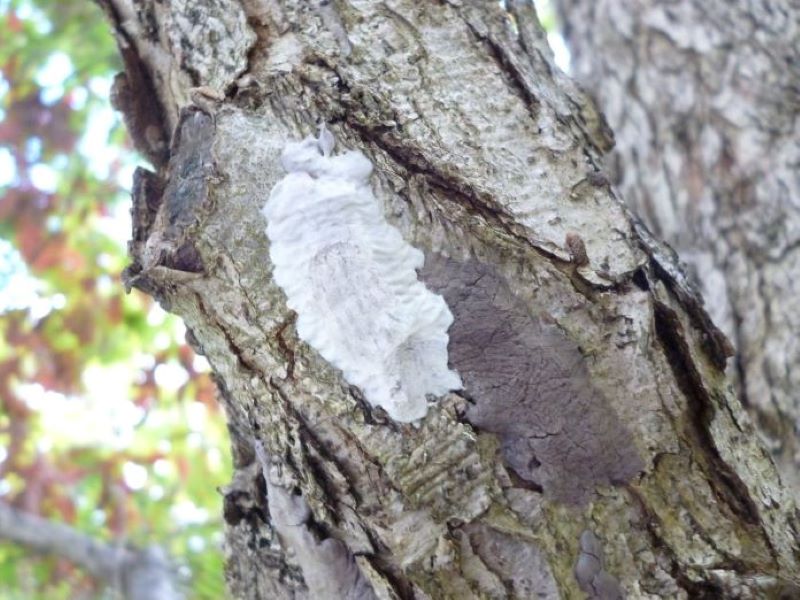
Spotted lanternfly egg masses. The white colored egg mass is only a few hours old. After less than a day the egg mass will turn a darker gray color & blend in with the bark of the tree. The masses contains 30-50 eggs each. (Photo Credit: Steven K. Rettke, Rutgers Coop. Ext.)
EUROPEAN HORNET (Vespra crabro): During the later weeks of summer & early weeks of fall the mysterious removal of bark sections typically found on branches of Birch, Rhododendron, and Lilac can sometimes be observed. These girdled or stripped bark sections are probably being done by European Hornets. These vespids have been reported to potentially have a worse temperament than timber rattlesnakes.
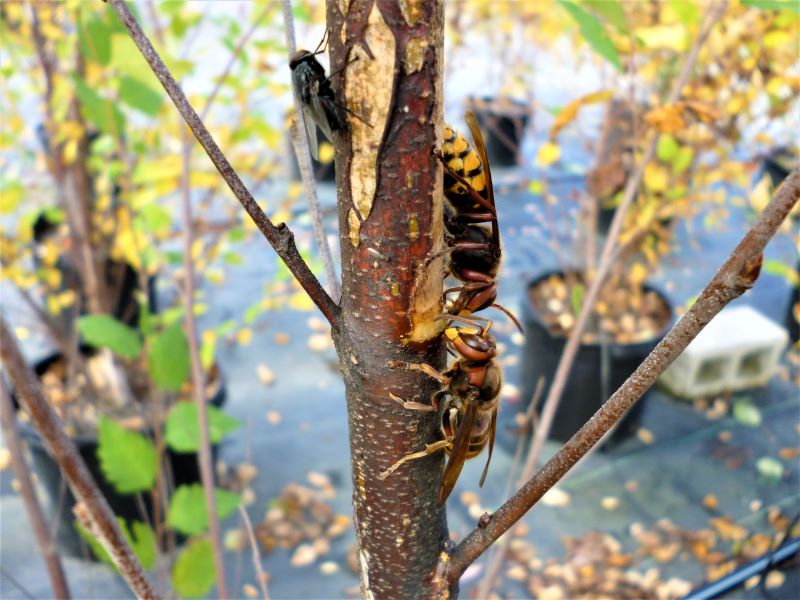
European hornets girdling the bark of branch stems. If branches are girdled, then all growth above this area will be killed. (Photo Credit: Steven K. Rettke, Rutgers Coop. Ext.)
European Hornets (Vespra crabro) are amber, honey-colored wasps and are 2X the size of bald-faced hornets. They are the largest, true hornets in North America. With powerful jaw-mandibles, the worker hornets can gouge significant bark sections to mix the woody tissue with their saliva to create paper nests and also feed young larvae. Branch feeding can also provide nourishment from the sap to the workers. If branches become girdled (they sometimes feed as if eating corn on the cob), then death above this area is inevitable since conducting tissues are severed. Compounding the problem, similar to yellow-bellied sapsuckers, these hornets often return each season to the same tree or shrub.
The size of European Hornet colony nests can range between 300-1000 workers. The colony can remain active until the late weeks of October & early November until all members begin to quickly die off, except for the queen. Only the overwintering queens survive within protected nest areas. Nests can typically be found near girdled trees/shrubs within the cavities of hollow tree trunks (often more than 6 feet above the ground). They can also be found within wall voids of building structures. Observing flight patterns away from host trees/shrubs may help to locate nest locations. However, workers will often be most actively foraging at night.

European hornets will often build nests in hollowed-out tree trunks. (Photo Credit: Steven K. Rettke, Rutgers Coop. Ext.)
There are no registered landscape or nursery pesticide materials for control. Plugging or use of an insecticide at entrance areas in trees or wall voids will probably not be effective since a new entrance will typically be created. When necessary, hire a professional exterminator for the safe removal of nests.
YELLOW JACKETS & HORNETS: During the spring and summer, hornets and wasps (e.g., native yellowjacks) are considered to be beneficial insects. These carnivorous predators can be especially effective against a variety of our native caterpillar pests (e.g., eastern tent caterpillars).

Yellow jacket: Excellent predator of native caterpillar pests. Photo Credit: Steven K. Rettke, Rutgers Coop. Ext.
During the late summer, the decreasing daylight hours signal yellow jackets and bald-faced hornets to produce new queens and drones. When they reach maturity, their diets change from high protein to high carbohydrate food sources. This change causes the workers to stop preying on insects and instead forage for sugars (such as sodas and other sweets commonly found at picnics). They therefore can become a major nuisance during late summer and early fall. To avoid defensive stinging, don’t swat at yellow jackets.

Yellow jackets become carbohydrate feeders during the late summer months. As an example shown above, they will feed on honeydew exuded by aphids & soft scale insects & become less effective predators. (Photo Credit: Steven K. Rettke, Rutgers Coop. Ext.)
Avoid wearing brightly colored and patterned clothing, since a wasp will likely explore further if a shirt looks like a flower or plant. Furthermore, body odor or bad breath can aggravate bees and wasps. If a person smells like one of the common predators of wasp nests (such as a bear or raccoon), then it becomes more likely that a wasp or hornet will react defensively. Therefore, wear plain, light-colored clothing, brush your teeth, and use unscented deodorant when in the area of foraging wasps and hornets. (Source: Ohio St. Univ. Ext.; P.E.S.T. Newsletter)
LEAFCUTTING BEES: (Family = Megachilidae) There are several genera of leafcutting bees within the family Megachilidae. Like honey bees, the numerous leafcutting bees are all valuable pollinators. However, with some ornamental plants in nurseries & landscapes, they can become a problem because of their leaf-notching behavior. They will typically select thinly textured leaves to marginally notch & then use the tissue for nesting material. Rosaceous plants are often notched, especially redbud (Cersis) & rose (Rosa). The notches are multiple times larger than observed with weevils (e.g., black vine weevils or two-banded Japanese weevils). Also, the cut margins made by leafcutting bees will be perfectly smooth. The diameter of the notches ranges from 0.25 to 0.5 inches across the leaf margins.

Leafcutting bee marginal notching has produced sizeable cuts around this redbud leaf. (Photo Credit: Steven K. Rettke, Rutgers Coop. Ext.)
The leafcutting bees do not negatively affect plant health but can cause aesthetic damage when leaf notching is numerous. This is usually more of a concern in nurseries when trying to sell plants. Since the bees do not feed on the leaves, the use of insecticides is not efficacious. Sometimes netting barriers such as cheesecloth can be effective.
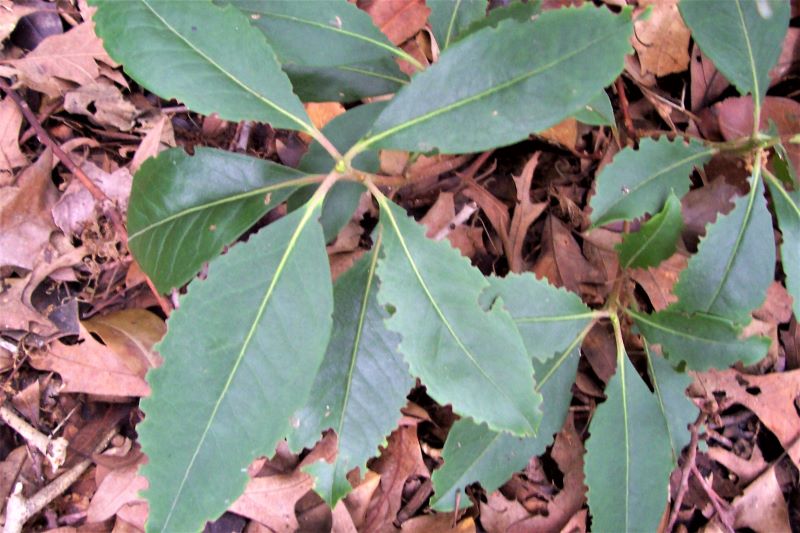
Compared to the notching produced from leafcutting bees, the marginal notches by black vine weevils are considerably smaller in size. (Photo Credit: Steven K. Rettke, Rutgers Coop. Ext.)
Reducing the number of leafcutting bees in the area can be attempted by eliminating nesting sites. Rotting wood containing small cavities is an ideal nesting site for these bees. Thick-stemmed plants with hollowed openings such as roses and bamboo are also commonly used as nesting areas. For example, preventing nesting in rose canes can be accomplished by sealing pruned ends with wax (sealing or candle), a few drops of white glue, wooden dowels, or thumbtacks.
SLUG/SNAIL FEEDING: Damage on herbaceous plants often appears “suddenly.” Look for irregular holes in the middle of the leaf & not along the edges. Slugs/snails are most actively feeding at night. If new growth emerges twisted or ragged, slugs/snails may have fed on dormant buds. Carefully monitor Hosta, daylily, & any annual/perennial bed that is heavily mulched. Consider removing some of the mulch to reduce slug habitat. Nursery container bays with consistent overhead irrigation will often be plagued by these pests. Apply slug/snail bait if necessary. Often during the summer months within the landscape, slug feeding on herbaceous plants is suspected, when Asiatic garden beetle adults are causing the damage.

Slug symptoms on eggplants. Slugs/snails will feed within the middle of leaves & not along the leaf margins. (Photo Credit: Steven K. Rettke, Rutgers Coop. Ext.)

Slugs/snails within a nursery container bay. They can sometimes build-up into large numbers. (Photo Credit: Steven K. Rettke, Rutgers Coop. Ext.)
APHIDS: Most of the aphid species that were present this spring on the new growth of certain plants (e.g., burning bush and spirea), have long ago left to feed on alternate hosts (often weeds). However, many shade trees (maples, oaks, lindens, birches, tulip poplars, etc.) still have populations of aphids. When encountered, first consider if the pest is presenting an aesthetic problem. Is the honeydew/sooty mold an eyesore on the tree or is it a nuisance, appearing on objects under the tree such as a car, patio furniture, or the house? Aphids rarely threaten the health of the tree, particularly later during the season. Action is only necessary if the customer is upset or inconvenienced by the presence of honeydew or sooty mold. If left alone, predators may maintain the population within acceptable levels.

Aphid species will often migrate to alternate hosts during the season. (Photo Credit: Steven K. Rettke, Rutgers Coop. Ext.)

Beneficial predators, such as this lady beetle larva will help suppress aphid pests. (Photo Credit: Steven K. Rettke, Rutgers Coop. Ext.)
HACKBERRY GALLS: Hackberry (Celtis) is a common native plant found growing in open fields, along roadsides, and in many types of soil. It is admirable that this hardy genus is especially able to grow well in dry soils. However, over 10 types of gall-making insects attack hackberry foliage. A common one is the hackberry nipple gall, which causes small, oblong protrusions on hackberry that are pale green to red in color. These galls are raised from the leaf surface, somewhat shaped like a nipple. They are most prevalent in shrubby forms of hackberry.

Hackberry nipple galls become most apparent late in the season when they reach their largest size. Although they are considered to be a pest, they are mostly just a curiosity. (Photo Credit: Steven K. Rettke, Rutgers Coop. Ext.)
Hackberry nipple gall adults are psyllids, about 0.3 inches in length, black in color, and have a jumping habit. Adults begin emerging in September and can continue to emerge well into the fall season. They can be extremely annoying to people, as they accumulate by the hundreds on top of cars, buildings, and other objects near large hackberry trees.
They will overwinter inside homes or in cracks and crevices of tree bark before becoming active again next spring. Eggs will be laid just as new growth emerges and then nymph feeding will cause new galls to form. As is the case with many types of leaf galls, they are a curiosity to many but rarely are chemical sprays warranted.
BANDED ASH BORER (Podosesia aureocincta)(3350 GDD = adult emergence): In September, this clearwing moth is mating and laying eggs on ash trees, especially green ash street trees (trees in open areas). Look for sawdust frass accumulating on the trunk, or small piles beneath the tree. Light brown pupal “skins” protrude from the trunk as a result of adult emergence. Pheromone traps are the best tools for judging when to apply controls. When the first male is caught in the trap (possibly around Labor Day), count 10 days, and then apply trunk sprays (e.g., Pyrethroids) before eggs hatch. Spray the trunk bark and major branches thoroughly. Research has also shown greater than 50% control by spraying tree bark with beneficial nematodes in October or late spring. This is a biological option for clients who refuse the use of any chemical insecticides on their property.

Open grown green ash street tree infested with banded ash clearwing moth borers. The symptoms are similar with emerald ash borers. (Photo Credit: Steven K. Rettke, Rutgers Coop. Ext.)

Banded ash borer pupal case. The adult clearwing moths emerge in September to mate & lay eggs on the bark. (Photo Credit: Steven K. Rettke, Rutgers Coop. Ext.)
OAK LACE BUGS (Corythucha arcuata): Every summer many oak trees throughout the area will show characteristic feeding damage from the oak lace bug. From a distance, the symptoms are similar to those of oak spider mites or classic leaf scorch. Closer inspection determines the identity of the pest.

Stippling symptoms on oak leaf from an infestation of oak lace bugs. They have similar symptoms to oak spider mite feedings. (Photo Credit: Steven K. Rettke, Rutgers Coop. Ext.)
Look for a batch of 30 to 50 tiny black “spikes” arranged in a circular area of ¾ inch diameter or less. This is not fecal material from the lace bugs but are the eggs of the oak lace bug. Adult females from the first generation laid second-generation eggs in mid-summer. These hatched several weeks ago & most are now maturing nymphs or adults. Eggs for the 3rd generation were seen last week in central NJ.
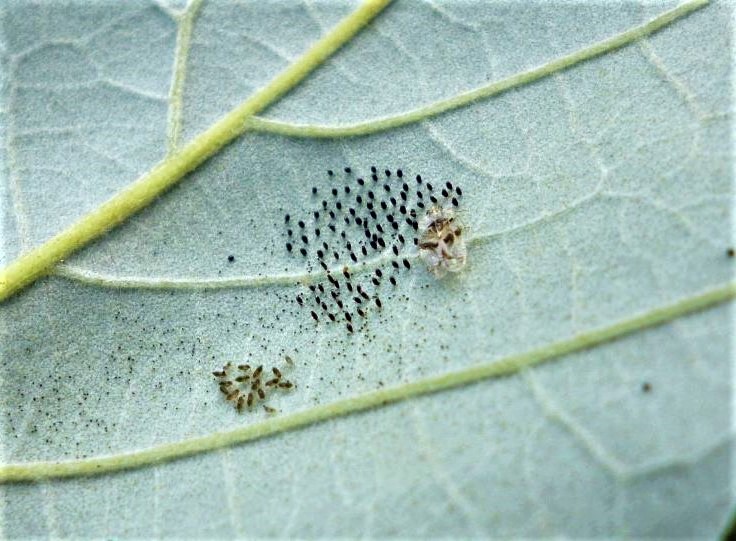
On the undersides of the leaf can be observed a few signs from oak lace bugs. Represented are a cluster of black, upright eggs, 1st instar nymphs recently emerged, & an egg laying adult. (Photo Credit: Steven K. Rettke, Rutgers Coop. Ext.)
Even though the leaf discoloration from foliage feeding symptoms by the oak lace bug can be alarming (to the extent that action seems necessary), spraying is generally not recommended. Tall landscape oaks would require a large volume of spray material (an exception can be argued for valuable trees in high visibility areas). Tree trunk injections with systemic insecticides may be of questionable value since the injection holes may do much more damage than the lace bugs. This pest primarily creates an aesthetic concern, since it is doubtful the insect is significantly reducing the tree’s ability to store starches and sugars for the next season.
SOFT SCALE CRAWLERS (Tuliptree scales (2032-2629 GDD) & Magnolia scales (2155-2800 GDD)): Although the species of most soft scale crawlers hatch and emerge during the late spring and early summer weeks, the magnolia and tuliptree scale species have active crawlers during the early fall. The Magnolia scale is the largest soft scale in North America and feeds only on magnolia trees. The Tuliptree scale, on the other hand, feeds on both tulip and magnolia trees.

Magnolia scales during late summer. Females can reach 1/2 inch in size late during the season. Shown are the yellow to reddish-brown females. (Photo Credit: Steven K. Rettke, Rutgers Ext.)

Tuliptree scales have a more rounded & hemispherical appearance compared to magnolia scales. Oozing honeydew is apparent as the scales suck sap from the phloem. (Photo Credit: Steven K. Rettke, Rutgers Coop. Ext.)
Egg laying by both scales has begun and will continue throughout most of September. During the middle of October, the hatching is completed, and black crawlers settle on branches to overwinter. Unlike many soft-scale species, neither tuliptree nor magnolia scales will ever leave tree bark to feed on foliage. Growth and feeding on bark continue through the spring and summer. It is during this period when most of the tree damage is done. By August, mating occurs, and eggs are laid again (only one generation occurs each year). During this period large populations produce much honeydew (with the corresponding sooty mold) which attracts ants, bees, and wasps.

Tuliptree scale crawlers hatching during September. Each female can lay over a thousand eggs. (Photo Credit: Steven K. Rettke, Rutgers Coop. Ext.)
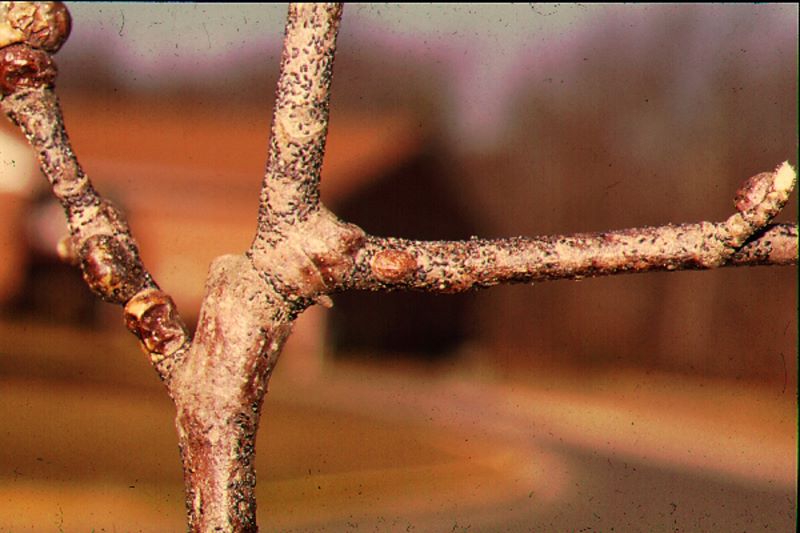
Magnolia & Tuliptree scales will overwinter on branches as dark colored 2nd instar nymphs . (Photo Credit: Steven K. Rettke, Rutgers Coop. Ext.)
Controls: In August and September, eggs are present under females and sprays are not effective. With small trees, hand-pick adults before eggs hatch and crawlers emerge. When treatments are required, wait until all crawlers have emerged and apply horticultural oil or residual insecticide in October. A dormant oil spray in late winter or early spring is also effective and will have the lowest impact on beneficials.
JAPANESE MAPLE SCALE (Lopholeucaspis japonica) (2500 GDD = 2nd generation crawler emergence): The 1st generation crawlers of the Japanese maple scale will continue to emerge in June & extend for 8 weeks after the initial hatch. Therefore, multiple spray treatments will be required when using short residual materials such as horticultural oils. This armored scale feeds within individual mesophyll cells on woody branches and typically causes more damage than will foliage feeders. They are more likely to generate individual branch dieback and can even kill trees. Since armored scales do not feed in vascular tissues they will not secrete honeydew and do not promote the corresponding black sooty mold. Unlike soft-scale species, armored scales typically are a highly persistent pest on woody plants and can continue for many years once established.

Male & female Japanese maple scales both have white, elongated waxy covers & only feed on woody bark tissues . (Photo Credit: Steven K. Rettke, Rutgers Coop. Ext.) .
Both male & female Japanese maple scales have a similar white, elongated waxy cover, but the females are larger. This is the only common armored scale species having these shape appearances that exclusively feed on bark in our region. Also, the removal of the cover will show the scale body to have a deep purple coloration. All these characteristics are diagnostic for the ID of the Japanese maple scale. Although the host range is large, within nurseries they are most often seen infesting maples. Other potential hosts include Firethorn, serviceberry, lilac, cotoneaster, Prunus, and others.

Removing the white wax from the Japanese maple scale will expose the purple coloration of the actual scale body. (Photo Credit: Steven K. Rettke, Rutgers Coop. Ext.).
The armored scale’s protective covering is produced by waxy filaments and glue exuded through ducts and pores on the body. Without the protective cover, an armored scale’s delicate “jelly-like” body would be extremely susceptible to desiccation and predation. This protective covering gives armored scales higher natural survival rates throughout the various life stages and allows for more conservative egg-laying. As a result, the average armored scale species only produces between 10 to 80 eggs per female. The survival rates of soft-scale species are much lower; therefore, many will lay as many as 1000 to 2000 eggs per female.
PRAYING MANTIDS: Are They Valuable Landscape Predators? Although they are excellent predators, contrary to popular belief, these well-known insects do not have a significant impact on the suppression of any key landscape pests. Praying mantids are generalist predators and should not be promoted to clients as viable control agents in the landscape or garden. They are indiscriminate feeders and will consume both pests and beneficial insects, including honey bees, lady beetles, butterflies, and lacewings. Furthermore, they are cannibalistic and highly territorial. Preying mantids can reach a large size late in the season as they molt, grow, & develop through the year. It is rare for them to maintain their numbers at densities high enough to contribute to major biological controls in the landscape.

During the spring, the hatching & emergence of approximately 100 praying mantids can occur from the average sized ootheca egg case. (Photo Credit: Steven K. Rettke, Rutgers Coop. Ext.)

This praying mantids impressive & lethal front claws (legs) is on full display. During the late summer & early fall they can reach a startlingly large size. (Photo Credit: Steven K. Rettke, Rutgers Coop. Ext.)
An old urban myth, apparently sometimes promoted by elementary school children, is that state laws protect praying mantids. There have never been any official state laws protecting this insect anywhere in the country. However, the destruction of this insect is not endorsed when observed. Its only crime is that they have incorrectly been awarded high status as valuable landscape predators.
BOXELDER BUGS & HOSTS: Boxelder bugs are dark-sucking insects with red wing markings/abdomens that build up in late summer/early fall. These insects are considered to be nuisance pests because of their habit of gathering in large numbers in sunny southern locations (such as your front door) as well as overwintering inside dwellings (such as your attic). Many older publications state that the only reproductive plant host for this bug is the female boxelder tree (a type of maple that often grows wild). Control measures were targeted at finding and removing this plant host, although this often resulted in poor long-term control.

Boxelder bugs have a distinctive black & red coloration. (Photo Credit: Joe Boggs, Ohio State Coop. Ext.)
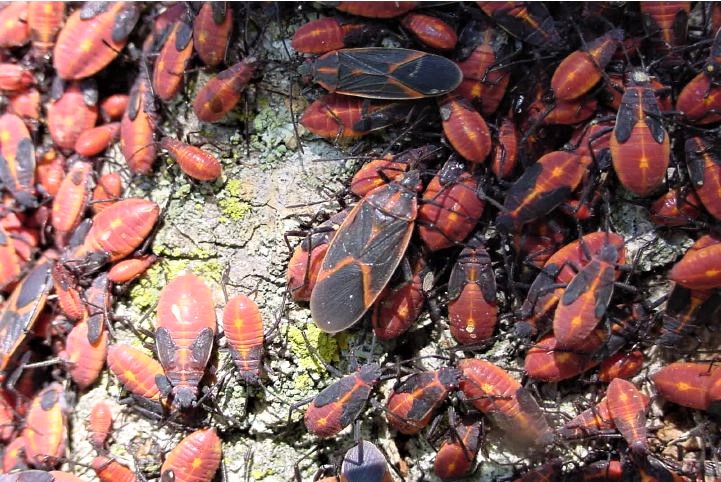
Boxelder bug adults & immature nymphs. (Photo Credit: Purdue University).
Over the past couple of decades, there have been many reports of boxelder bugs feeding and breeding on different plants. The following is a list of plant hosts documented as a food source for boxelder bugs: apple, cherry, plum, peach, pear, grapes, almond, pistachio, strawberry, tulip, ash, pin oak, tree of heaven (Ailanthus), mulberry, elderberry, iris, hollyhock, peony, asparagus, ampelopsis, geranium, cacti, lilies, coleus, ageratum, pigweed, crabgrass, and foxtail grass. (Ref. R. Rosetta, Oregon State: D. Shetlar, Ohio St.)
REDHEADED PINE SAWFLY (Neodiprion lecontei): Primarily a pest of 2 and 3-needle pines, these pests are rarely seen feeding on other conifers. Fully-grown sawfly larvae are 1 inch long with reddish heads and yellowish-white bodies with rows of black spots. Heavy infestations can cause defoliation and may kill small pines. There are two generations per year with the second from August through October.

The 2nd generation of redheaded pine sawflies can potentially still be found actively feeding into the month of October on 2-3 needle pines. (Photo Credit: Steven K. Rettke, Rutgers Coop. Ext.)
Pine trees located in stressful sites are most readily prone to attack. When larvae are small, their mouthparts cannot consume the entire needle. This partial feeding causes a few dry, curled, golden brown needles at the tips of branches. Careful observation during late spring, & summer may uncover brown, oval, 0.25-inch pupal cases attached to a branch. These cocoons are the pupation stages from the 1st generation of redheaded pine sawflies. The 2nd generation late season sawflies will overwinter as cocoons within the soil.

Pupal case of 1st generation redheaded pine sawfly attached to a branch. It will emerge as an adult wasp & lay eggs to begin the 2nd generation during the last half of the summer. (Photo Credit: Steven K. Rettke, Rutgers Coop. Ext.)
Handpick or prune out small populations of larvae feeding in clusters. Horticultural oils and soaps can control populations when the larvae are young and small, with thorough coverage. When larvae are larger, various residual pesticides can be sprayed, including Conserve (spinosad). Since the sawflies are not caterpillars, the bacterial insecticide B.t. (Bacillus thuringensis) will NOT be effective.
HEMLOCK PESTS: Elongate hemlock scale (Fiorinia scale) (2515-2625 GDD) and hemlock woolly adelgid are two pests of hemlocks that can be controlled during late summer & fall. Although both of these pests can potentially kill hemlocks, the elongate hemlock scale can be more difficult to control. The vulnerable second-generation crawler activity of this armored scale occurs during late August or September.The males of elongate hemlock scale produce white waxy filaments on needles that can resemble hemlock woolly adelgids at first glance. The females are reddish-brown & are significantly larger than the males. They will both be found on the needles. The crawler emergence range is rather short compared to many other armored scale species. Waiting shortly until after they have all emerged will give best results with a single spray application. Spray treatments during the weeks of September should give best results.

The elongate hemlock scale males produce white waxy threads that can often obscure the presence of the larger reddish-brown females that are on the needles. (Photo Credit: Steven K. Rettke, Rutgers Coop. Ext.)
Alternatively, hemlock woolly adelgid nymphs are still exposed at the base of this year’s needles and will not cover themselves with the protective white waxy threads until later in the fall (e.g., October). Since drought-stressed trees are often relieved during September with increased rainfall and decreased temperatures, horticultural soaps and oils can often be more safely used now on sensitive hemlocks. The exclusive use of horticultural oil (1-2%) against the hemlock woolly adelgid can give outstanding results. Excellent coverage is mandatory on the outer branch tips and both sides of the needles. Achieving adequate coverage with large trees can be difficult. With large hemlock trees, systemics such as imidacloprid (Merit) has been the product of choice during the past few decades & can provide a full year residual. Although more commonly applied in the spring or fall months, this material can be administered as a soil drench anytime the soils are not frozen & they contain adequate moisture. Remember, within NJ, after October of 2023, the neonicotinoids will no longer be legal to apply within residential landscapes.

Hemlock woolly adelgids are lined up along the bases of leaf petioles. They will be fully exposed during the next couple of months (September & early October). These oval, black colored disked shaped adelgids are your targets when applying insecticide sprays. During late October & November, the overwintering adelgids will develop protective white waxy threads (sacs) around themselves. In early spring they will begin to lay reddish colored eggs within the white sacs. (Photo Credit: John Davidson, Univ. of Maryland)
WITCHES’ BROOMS: The development of witches’ brooms on woody plants and the resulting formation of abnormal growth can cause curiosity and concern to your clients. Typically, the new growth is distorted, and a proliferation of leaves or fruit/cones closely clumped together appears when apical dominance is lost. Witches’ Brooms are created on plants when the transfer of growth hormones is disrupted (perhaps caused by the introduction of a foreign substance). Insects (e.g., aphids), fungi, bacteria, phytoplasmas, and herbicides have all been implicated in causing the formation of witches’ brooms in many plant species. It is interesting to note that sub-lethal doses of glyphosate (Round-Up) when applied late in the season can cause witches’ brooms on new plant growth the following spring.

The dwarf Alberta spruce is actually a witches’ broom of the white spruce. A genetic reversion has occurred with the photo above & a few of the Alberta spruce branches have changed back to begin to grow as a white spruce. (Photo Credit: Steven K. Rettke, Rutgers Coop. Ext.)

Interestingly, the Poinsettia plant is actually a witches’ broom caused by a phytoplasma infection. The original poinsettia that grows wild is a large plant (small tree) that has widely spaced open branches. The witches’ broom creates a small, compact plant with short branch internodes. Therefore making the plant ideal for tabletop Christmas decorations. (Photo Credit: Steven K. Rettke, Rutgers Coop. Ext.)
ARE LICHENS HARMFUL TO TREES/SHRUBS?: The blue-green colored lichens growing on the bark of trunks and stems are the well-known mutualistic association between fungi and algae. Lichens have prolific growth when exposed to full sunlight. Sometimes clients may become concerned with lichen growth on their trees or shrubs, especially after crown thinning has opened up the canopy and the increased sunlight promotes further growth. Nearly all of the literature states that lichens are purely superficial and cause no harm to the health of trees/shrubs. Interestingly, a few non-scientific studies have indicated that lichens may have some detrimental health effects. For example, it has been postulated that lichens may disrupt gas exchange within trees. Furthermore, these organisms can release acids that can break down rocks and hence, it is suggested some damage to plants does occur. However, until replicated and controlled scientific studies prove otherwise, we should continue to reassure our clients that these curious growths on their trees/shrubs are of no concern.

Lichens are the mutualistic association between fungi & algae. No scientific research has demonstrated that they cause any harm to tree stems they grow upon. (Photo Credit: Steven K. Rettke, Rutgers Coop. Ext.)
GRINDING STUMPS: When a tree is removed from a property, the owner typically requests tree replacement recommendations. However, it is important to remember to grind up the old tree stump before any new trees are placed near it. Several root-rotting fungi can become pathogens to living trees that are nearby. Some of the potential pathogens include Xylaria root rot (Dead Man’s Fingers), Ganoderma lucidum (Ganoderma root & butt rot), and Armillaria mellea (Armillaria root rot). With a sizable food source such as a dead stump, these dead wood decay fungi can eventually become primary pathogens and infect live plants. By grinding the stumps, the food source is mostly removed, and these fungi become less of a threat.

Stump grinding is recommended after tree removals, especially if new tree transplants will be replanted near-by. (Photo Credit: Steven K. Rettke, Rutgers Coop. Ext.)

